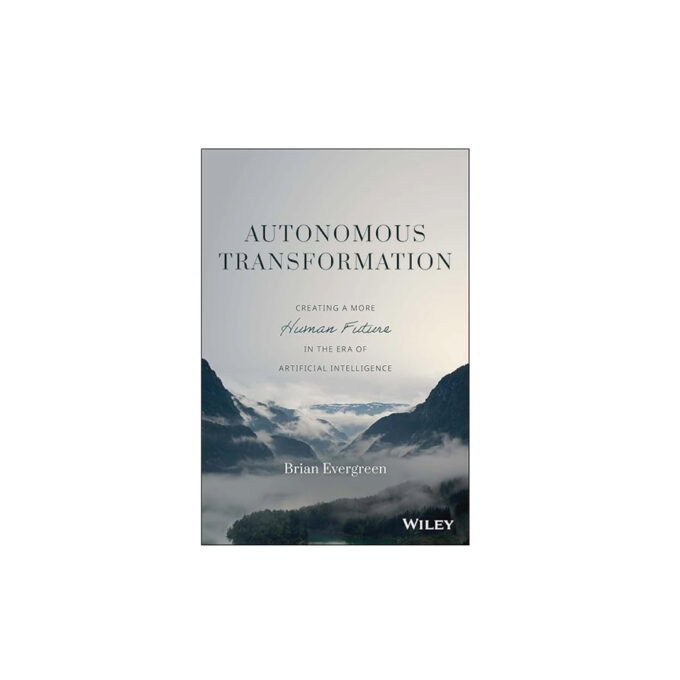I by IMD Book Club
Artificial intelligence
The future-solving methodology: Insights on AI and leadership
May 30, 2025 • by Brian Evergreen, Stefan Michel in I by IMD Book Club
Brian Evergreen shares radical insights from his book Autonomous Transformation: Creating a More Human Future in the Era of AI with IMD’s Stefan Michel....
Brian Evergreen shares radical insights from his book Autonomous Transformation: Creating a More Human Future in the Era of AI with IMD’s Stefan Michel.
Problem solving is the craft of getting rid of what you don’t want. Future solving is the craft of getting what you do want.Brian Evergreen
Central to Autonomous Transformation: Creating a More Human Future in the Era of AI is author Brian Evergreen’s definition of profit: the difference between what it costs you to make something and what someone else is willing to pay for it. Whereas, historically, profit has been associated with greed, Evergreen argues we should decouple the two and conceive of greed – making money at all costs – as occupying one end of a spectrum, with altruism – good at all costs – at the other. And the average working person today occupies a position of neutrality somewhere the middle, just trying to make an honest living. From this we get the concept of “profitable good”: doing good while remaining profitable.
Why does this matter? In terms of the impact of technology on us, Evergreen proposes a shift from traditional digital transformation to autonomous transformation, where organizations not only adopt AI technologies but do so in a way that preserves and enhances human connection; the goal being to ensure technology serves humanity, not the other way around.

The autonomous transformation cycle: five steps
The author has another radical perspective on the concept of the business model: don’t start with the problem you want to solve, because “problem solving is the craft of getting rid of what you don’t want”, which limits you from the get-go. Instead, he argues, “Future solving is the craft of getting what you do want and what you actually want to do.” To do this, he identifies five steps:
1. Envision your future
Start by envisioning what future you actually want for yourself, your organization, and your market. As the author notes, we tend to think of envisioning as something we hire a big consulting firm to do for us, but it’s a skill we can all learn with practice.
2. Discover and rediscover (whole-systems thinking)
Often when we conceive a bold and ambitious vision for the future, we don’t have enough context to develop and execute it. This stage is about applying whole-systems thinking to see the complete picture of what it is that you’re looking at and thinking about it in a different way. This means thoroughly understanding each and every part of the whole and how they move within it – but you need to go further and re-examine your basic assumptions. Have you assumed that certain pieces are immovable that may in fact be moved? Are there market forces that could be re-engineered? You can’t make your part of the overall system better unless interactions with the other parts are improved in concert.
3. Dispel the digital fog
Evergreen is quick to point out that he wrote Autonomous Transformation before anyone had even heard of ChatGPT – “and there was a lot of digital fog back then” – so the need to clear the fog is exponentially greater now. This is about dispelling the hype and misinformation around AI, such as the “appeal to authority” fallacy, where non-experts’ AI opinions are taken out of context, to understand what is true about the technologies and their actual capabilities – “You need to have a level of literacy about them in order to be able to solve how you’re going to use them.”
4. Design for inevitability
The fourth step is to strategize in such a way that success becomes inevitable. What has to true in order for your goal to be realized? Even if it seems crazy, consider how it can be made to happen. This means designing with audacity to come up with solutions that you wouldn’t have otherwise come up with. This leads to a strategy and a plan for making your goal not only actionable and achievable, but inevitable.
5. Lead a more human future
The final part in the schema is really about how you lead people, “because your strategy and your vision will only be as effective as your ability to articulate them and spark action”. If you cannot motivate people to follow, fund, and support you, your vision and strategy simply wither and die.
To be able to come up with economic models and social contracts between people and organizations is a uniquely human capability.
Value creation: a distinctly human skill
The above is a brief overview of some of the novel concepts in a truly fascinating and thought-provoking book. There are many more insights on AI adoption pitfalls (how over-automation can dehumanize customer experience; why the human touch matters; the explosive growth of Generative AI (helpful as an interface or “mouth” but not as the central “brain” of AI agents); and even reflections on raising children in an AI-driven world.
And lest we worry that the AI era may replace humans in critical business tasks, Evergreen assures us that it can’t be used for new value creation: “That’s a distinctly human skill, and to be able to come up with economic models and social contracts between people and organizations is a uniquely human capability.”
Authors

Brian Evergreen
Author, senior advisor, researcher, and keynote speaker
Brian Evergreen is the author of Autonomous Transformation: Creating a More Human Future in the Era of AI, named a Next Big Idea Club “Must-Read” and one of the Thinkers50 Top 10 Best New Management Books for 2024. In 2025, Evergreen was named one of the Top 50 AI Creators You Need to Know by Edelman and was selected by Thinkers50 as one of the Top 30 Thinkers Redefining Leadership in 2025. He is best known for his work advising some of the world’s most valuable companies on positioning their organizations for the future in the era of AI.
Evergreen’s insights draw from his personal experience at leading companies, including Accenture, AWS, and Microsoft. When he’s not giving keynotes or advising companies on AI, Brian guest lectures at the Kellogg School of Management, sharing the unconventional and innovative methods and frameworks he’s developed, which have supported over $20B of investment. He is the founder of The Future Solving Company, where he helps organizations position themselves for the future in the era of AI, and is an advisor to over a dozen Fortune 500 companies. His work has been featured on Bloomberg, Forbes, Fast Company, CIO, VentureBeat, the Next Big Idea Club, and Thinkers50.

Stefan Michel
Professor of Management and Dean of Faculty and Research
Professor Stefan Michel‘s primary research interests are AI’s impact on strategy, pricing, and customer-centricity. He has written 13 books, numerous award-winning articles and ranks among the top 40 bestselling case study authors worldwide by The Case Centre. He is currently Dean of Faculty and Research at IMD and is also Program Director for two IMD programs: the 10-day Breakthrough Program for Senior Executives (BPSE), guiding leaders in defining their next breakthrough; and Strategic Thinking, an 8-week online program with 1-1 coaching, helping professionals become better strategists while working on a concrete strategic initiative for their organizations.
